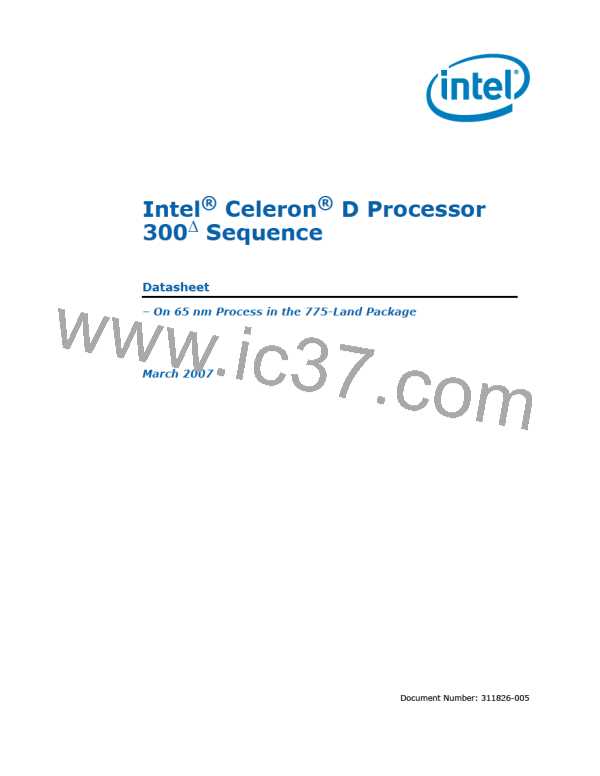Features
6.2.2.1
HALT Powerdown State
HALT is a low power state entered when all the logical processors have executed the
HALT or MWAIT instructions. When one of the logical processors executes the HALT
instruction, that logical processor is halted, however, the other processor continues
normal operation. The processor will transition to the Normal state upon the occurrence
of SMI#, BINIT#, INIT#, or LINT[1:0] (NMI, INTR). RESET# will cause the processor to
immediately initialize itself.
The return from a System Management Interrupt (SMI) handler can be to either
Normal Mode or the HALT Power Down state. See the Intel Architecture Software
Developer's Manual, Volume III: System Programmer's Guide for more information.
The return from a System Management Interrupt (SMI) handler can be to either
Normal Mode or the HALT Power Down state. See the Intel Architecture Software
Developer's Manual, Volume III: System Programmer's Guide for more information.
The system can generate a STPCLK# while the processor is in the HALT Power Down
state. When the system de-asserts the STPCLK# interrupt, the processor will return
execution to the HALT state.
While in HALT Power Down state, the processor will process bus snoops.
6.2.2.2
Enhanced HALT Powerdown State
Enhanced HALT is a low power state entered when all logical processors have executed
the HALT or MWAIT instructions and Enhanced HALT has been enabled via the BIOS.
When one of the logical processors executes the HALT instruction, that logical processor
is halted; however, the other processor continues normal operation.
The processor will automatically transition to a lower frequency and voltage operating
point before entering the Enhanced HALT state. Note that the processor FSB frequency
is not altered; only the internal core frequency is changed. When entering the low
power state, the processor will first switch to the lower bus ratio and then transition to
the lower VID.
While in Enhanced HALT state, the processor will process bus snoops.
The processor exits the Enhanced HALT state when a break event occurs. When the
processor exits the Enhanced HALT state, it will first transition the VID to the original
value and then change the bus ratio back to the original value.
6.2.3
Stop Grant State
When the STPCLK# signal is asserted, the Stop Grant state of the processor is entered
20 bus clocks after the response phase of the processor-issued Stop Grant
Acknowledge special bus cycle.
Since the GTL+ signals receive power from the FSB, these signals should not be driven
(allowing the level to return to VTT) for minimum power drawn by the termination
resistors in this state. In addition, all other input signals on the FSB should be driven to
the inactive state.
BINIT# will not be serviced while the processor is in Stop Grant state. The event will be
latched and can be serviced by software upon exit from the Stop Grant state.
RESET# will cause the processor to immediately initialize itself, but the processor will
stay in Stop-Grant state. A transition back to the Normal state will occur with the de-
assertion of the STPCLK# signal.
A transition to the Grant Snoop state will occur when the processor detects a snoop on
the FSB (see Section 6.2.4).
Datasheet
87

 INTEL [ INTEL ]
INTEL [ INTEL ]